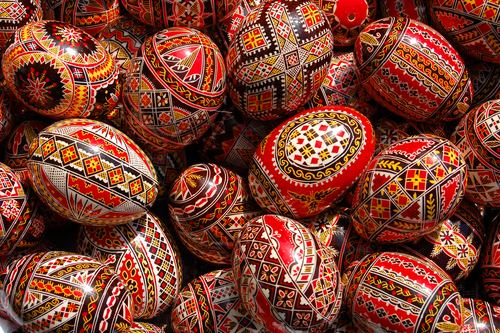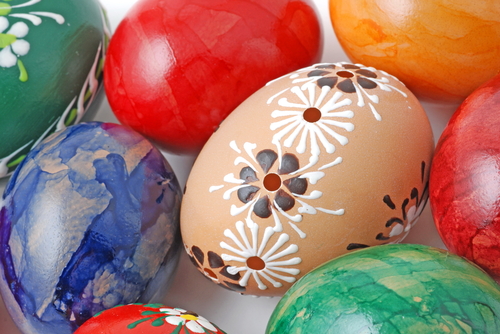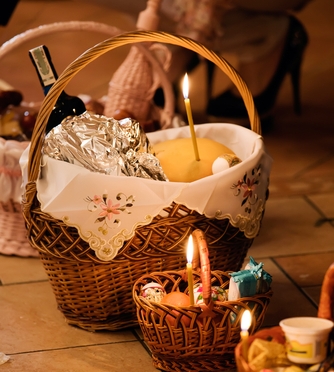On the Easter Sunday people usually go to church, spend the day with their families and exchange greetings. The traditional ‘Christ is risen!’ greeting for this holy day should always be answered with ‘Risen indeed’ reply. After the night (more common for small towns and villages) or morning (popular in big cities, where people tend to pay less attention to religious rituals) mess, people go back home to enjoy the festive holy dinner with their families. People always prepare special food for Easter and stick to some distinguishable for Ukraine rituals.
Read: Orthodox Easter in Ukraine
Dyed Eggs
The krashanky and pysanky (Easter eggs) are an old pre-Christian element and have an important role in the Easter rites. Decorating eggs for Easter was banned under Soviet rule as a religious practice, but kept alive by many crafters working in secret. Pysanka (which comes from the Ukrainian word for ‘to write’) are not painted: the designs are traced out in beeswax and the egg is then dipped into dye. The dye colors the egg where it is bare but leaves it white where the wax protects it. The process is then repeated as many times as desired (working from the lightest dye to the darkest) to create an intricate, many-layered pattern.

Most people these days call any patterned Ukrainian Easter egg as pysanka, but there are dozens of terms referring to specific methods of preparation. The most important difference to know is that pysanka is a raw egg (sometimes drained through a tiny drilled hole so that they may be preserved). Pysanka is a piece of art and requires good amount of time to create it.

Krashanka is a dyed hardboiled egg, usually monocolor, meant for eating at the Easter feast. Traditionally, Ukrainians used natural dyes like onion peel for rich mahogany and beet root for red and pink colors.
Easter Cake (Paska or Kulich)

Traditional Paska loaves are tall and cylindrical, with symbols made of rolled dough or dusted in flour on the top. The process of baking Easter cake was traditionally a ceremonial affair, during which the household was expected to stay quiet and still. The recipes of Paskas vary from area to area.They can be very sweet and fluffy or more savory and dense, while the original ones were made with cottage cheese and sour cream.
Easter Baskets

The Paska bread, red wine, krashanky and pysanky, along with non-Lenten foods like sausage, cheese, lard, and ham, are placed in a basket with lit candles and brought to church for Mass on Easter morning (modern life, especially in big cities, has put a little bit away the tradition of night masses). The Easter baskets are blessed by the priest as part of the mass and taken home by the families to eat in the morning.
Rituals
It is typical for Ukraine to begin the Easter celebrations with the game called ‘egg battles’ or ‘egg knocking’: two people rap their krashanky together, and if someone’s eggshell breaks, that person is out of the game (or has to give the egg up, or eat it, depending on family tradition).
The rite of sprinkling with water is still carried on in Western Ukraine on the next day after Easter and is called Wet Monday (Oblyvanyi ponedilok). It is practiced by young people: the boys usually splashing the girls with water.
During Easter season in Ukraine the cult of the dead is observed. The dead are remembered during the whole week after Easter, especially on the first Sunday following Easter Sunday. People gather in the cemeteries, bringing with them a dish containing some food and wine, which they consume, leaving the rest at the graves.
Easter in Ukraine is one of the biggest and most loved holidays among people because of its spiritual meaning and festive atmosphere created with beautiful traditions and cheerful mood. The Orthodox Easter in Ukraine will be celebrated on May 1 in 2016.







